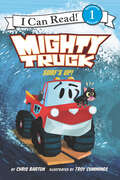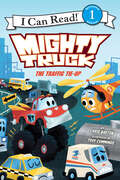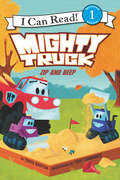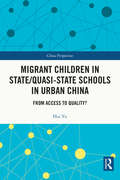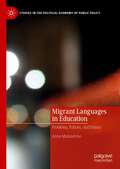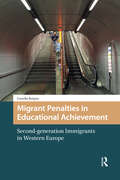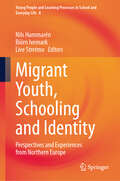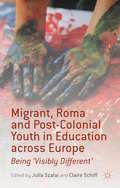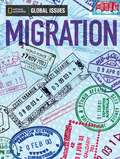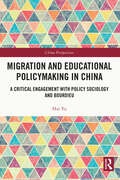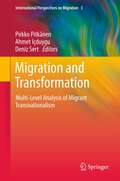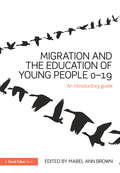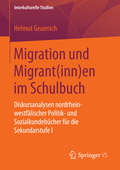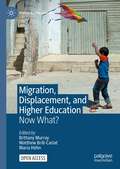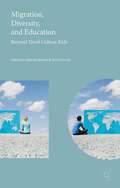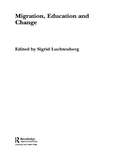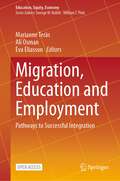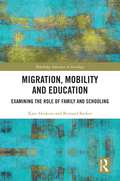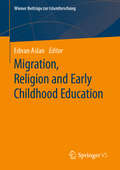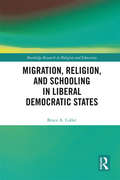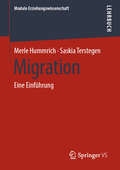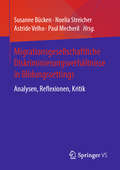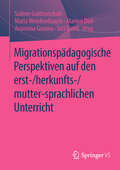- Table View
- List View
Mighty Truck: Surf's Up! (I Can Read Level 1)
by Chris BartonClarence was just a muddy pickup. One day there was a big storm, and lightning zapped the car wash. Now Clarence has a secret: Water turns him into MIGHTY TRUCK!Clarence decides to join his neighbor, Mr. Dent, and his cat, Throttle, for a warm day of surfing waves at the beach. But Throttle gets into some gnarly water after Clarence learns that Throttle can’t swim. Mr. Dent needs Clarence’s help to rescue his cat!Can Mighty Truck save the day?Might Truck: Surf’s Up is a Level One I Can Read, which means it’s perfect for children learning to sound out words and sentences.
Mighty Truck: The Traffic Tie-Up (I Can Read Level 1)
by Chris BartonClarence was just a muddy pickup. One day, there was a big storm and Lightning zapped the car wash. Now Clarence has a secret: Water turns him into MIGHTY TRUCK!Everyone has a job to do in Axleburg. Stella’s job is to be a news chopper and fly high in the sky to loudly report what she sees. But Stella is loud all the time, and Clarence cannot stand it!Clarence and his friends teach Stella to use her inside voice by speaking wheely softly and only letting her engines purr. Stella learns to use her inside voice, only she uses it outside, too! When Stella is too quiet to report the traffic on the morning rush, there’s only one truck who can turn up the volume and save the day: Mighty Truck!Mighty Truck: Traffic Tie-Up is a Level One I Can Read book, which means it’s perfect for children learning to sound out words and sentences.
Mighty Truck: Zip and Beep (I Can Read Level 1)
by Chris BartonClarence was just a muddy pickup. One day there was a big storm, and lightning zapped the car wash. Now Clarence has a secret: Water turns him into MIGHTY TRUCK!Mighty Truck is super strong, super fast . . . and a super fun babysitter!When Hattie’s bulldozer cousins Zip and Beep visit Axleburg, Clarence offers to watch them on his day off. Zip and Beep play tag, kick the can, and jump jumper cables—but no matter how fast they zoom, Zip and Beep just don’t run out of gas! How can Clarence keep up with these wheely energetic youngsters? Sounds like a job for Mighty Truck!Mighty Truck: Zip and Beep is a Level One I Can Read book, which means it’s perfect for children learning to sound out words and sentences.
Migrant Children in State/Quasi-state Schools in Urban China: From Access to Quality? (China Perspectives)
by Hui YuHighlighting the changing landscape of Chinese urban state schools under the pressure of recruiting a tremendous number of migrant children, this book examines the quality of state educational provisions from demographic, institutional, familial and cultural angles. Rooted in rich qualitative data from five Chinese metropolitan cities, it identifies the demographic changes in many state schools of becoming ‘migrant majority’ and the institutional reformation of ‘interim quasi-state’ schools under a low cost and inferior schooling approach. This book also digs into the ‘black box’ of cultural reproduction in school and family processes, revealing both a gloomy side of many migrant children’s academic underachievement as a result of troubled home-school relations and a bright side that social inclusion of migrant children in state school promotes their adaptation to urban life. The author concludes that migrant children’s experiences in state (and quasi-state) schools turn them into a generation of ‘new urban working-class’. The monograph will be of interest to scholars, students, practitioners and policymakers who want to better understand educational equality for migrants and other marginalised groups.
Migrant Languages in Education: Problems, Policies, and Politics (Studies in the Political Economy of Public Policy)
by Anna MalandrinoThis book examines language education policy in European migrant-hosting countries. By applying the Multiple Streams Framework to detailed case studies on Austria and Italy, it sheds light on the factors and processes that innovate education policy. The book illustrates an education policy design that values language diversity and inclusion, and compares underlying policymaking processes with less innovative experiences. Combining empirical analysis and qualitative research methods, it assesses the ways in which language is intrinsically linked to identity and political power within societies, and how language policy and migration might become a firmer part of European policy agendas. Sitting at the intersection between policy studies, language education studies and integration studies, the book offers recommendations for how education policy can promote a more inclusive society. It will appeal to scholars, practitioners and students who have an interest in policymaking, education policy and migrant integration.
Migrant Penalties in Educational Achievement: Second-generation Immigrants in Western Europe (Changing Welfare States)
by Camilla BorgnaThe integration of second-generation immigrants has proved to be a major challenge for Europe in recent years. Though these people are born in their host nations, they often experience worse social and economic outcomes than other citizens. This volume focuses on one particular, important challenge: the less successful educational outcomes of second-generation migrants. Looking at data from seventeen European nations, Camilla Borgna shows that migrant penalties in educational achievement exist in each one-but that, unexpectedly, the penalties tend to be greater in countries in which socio-economic inequalities in education are generally more modest, a finding that should prompt reconsideration of a number of policy approaches.
Migrant Teachers: How American Schools Import Labor
by Lora BartlettMigrant Teachers investigates an overlooked trend in U. S. public schools today: the growing reliance on teachers trained overseas, as federal mandates require K-12 schools to employ qualified teachers or risk funding cuts. A narrowly technocratic view of teachers as subject specialists has led districts to look abroad, Lora Bartlett asserts, resulting in transient teaching professionals with little opportunity to connect meaningfully with students. Highly recruited by inner-city school districts that struggle to attract educators, approximately 90,000 teachers from the Philippines, India, and other countries came to the United States between 2002 and 2008. From administrators' perspective, these instructors are excellent employees--well educated and able to teach subjects like math, science, and special education where teachers are in short supply. Despite the additional recruitment of qualified teachers, American schools are failing to reap the possible benefits of the global labor market. Bartlett shows how the framing of these recruited teachers as stopgap, low-status workers cultivates a high-turnover, low-investment workforce that undermines the conditions needed for good teaching and learning. Bartlett calls on schools to provide better support to both overseas-trained teachers and their American counterparts.
Migrant Youth, Schooling and Identity: Perspectives and Experiences from Northern Europe (Young People and Learning Processes in School and Everyday Life #8)
by Nils Hammarén Biörn Ivemark Live StretmoThis volume provides a broad outlook on migrant youth and schooling in Sweden, Denmark, Norway, Iceland and the United Kingdom. It explores empirically how these young people—who range from the first to the third generation—position themselves in relation to school, friendships, language-use, aspirations, and the expectations placed upon them. The book also examines the role of a variety of professionals, street-level bureaucrats, and other key actors in framing, representing, problematizing and ultimately contributing to shaping the experiences of these young people. Contemporary contextual challenges for educational advancement are particularly highlighted, as are key issues of cultural representation and recognition. Several contributions also focus on sub-groups within the immigrant-origin population that have so far only received a limited attention in the literature, such as youth in rural areas, LGBT youth, first-in-family college students, and youth who transition out of anti-school subcultures. The contributors stem from a variety of disciplines, ranging from Education and Youth Studies to Social Work and Sociology, and tackle many innovative themes, such as peer violence, special needs education, and artistic interventions, among many others. Through this original perspective and comparative outlook, the book makes an important contribution to the literature on youth, migration, identity, and education. It will interest undergraduate students in several areas of the social sciences, teachers and other professionals who work with children and young people.
Migrant, Roma and Post-Colonial Youth in Education across Europe
by Julia Szalai Claire SchiffThis book compares the educational experiences of adolescents from a variety of 'visible' ethnic minority groups across Europe. Focusing on underprivileged urban contexts, it reveals the structural inequalities, as well as the often conflicting inter-ethnic relations which develop in classrooms, playgrounds and larger communities.
Migration [Below-Level]
by Andrew J. MilsonExamines the forces behind migration, the challenges that migrants face, and the ways in which new populations enrich their communities
Migration and Educational Policymaking in China: A Critical Engagement with Policy Sociology and Bourdieu (China Perspectives)
by Hui YuBy concentrating on the topic of school enrolment policy for rural-to-urban migrant children in China, this book analyses the unequal power relations and structural inequalities that can appear in the context of education. The author complements current knowledge by applying theoretical resources of policy sociology, in particular the thinking of Pierre Bourdieu, into analysis of educational policymaking in the Chinese context. He takes a policy trajectory approach to trace the (unequal) power relations and structural inequalities invested and realised in the school enrolment policy. Rooted in rich qualitative data from five metropolises, he examines both external influences of politics, economy and public policy on educational policy agenda setting and discursive practices within the educational policy cycle, inherent in the post-2013 restrictive school enrolment policy. Structural constraints and agency in the local context are also explored, indicating that the intersectional effects of political, economic, and civic logic can result in differentiated modes of policy enactment. The study will be of interest to scholars, students, policymakers and practitioners in helping address policymaking and social justice in education for migrants and other marginalised groups.
Migration and Transformation:
by Pirkko Pitkänen Deniz Sert Ahmet IçduyguPeople's transnational ties and activities are acquiring ever greater importance and topicality in today's world. The focus of this book lies in the complex and multi-level processes of migrant transnationalism in four transnational spaces: India-UK, Morocco-France and Turkey-Germany and Estonia-Finland. The main question is, how people's activities across national borders emerge, function, and change, and how are they related to the processes of governance in increasingly complex and interconnected world? The book is based on the findings of a three-year research project TRANS-NET which brough together internationally acknowledged experts from Europe, Asia and Africa. As no single discipline could investigate all the components of the topic in question, the project adopted a multi-disciplinary approach: among the contributors, there are sociologists, policy analysts, political scientists, social and cultural anthropologists, educational scientists, and economists. The chapters show that people's transnational linkages and migration across national boundaries entail manifold political, economic, social, cultural and educational implications. Although political-social-economic-educational transformations fostered by migrant transnationalism constitute the main topic of the book, the starting assumption is that the large-scale institutional and actor-centred patterns of transformation come about through a constellation of parallel processes.
Migration and the Education of Young People 0-19: An introductory guide
by Mabel Ann BrownMigration and the Education of Young People 0–19 investigates migration from a number of perspectives to consider the changing dynamics of society within different countries. Examining the data associated with global migration by focusing on case studies from a wide range of countries, it provides detailed and balanced coverage of this politically sensitive topic to explore the educational needs of migrant young people, the impact of large-scale migration to and from countries and the policy challenges that individual countries face when ensuring adequate provision for migrant young people within their education systems. Chapters cover: The reasons why people might move Social and emotional learning in Britain: a tool to guard against cultural pollution? Migration into a global city: the economic and educational success of London Latvian people on the move and the impact on education People’s movement – Greece Return migration in Lithuania: incoming challenges for children’s education The United States, Latin America, immigration and education Tanzanian street children: victims, ordinary lives or extraordinary survivors? This book explores the changing social dynamics through an extensive range of case studies and will be an essential resource for students taking undergraduate and postgraduate courses in education, sociology and international relations.
Migration und Migrant(inn)en im Schulbuch
by Helmut GeuenichSchulbücher filtern - wie andere Massenmedien auch - Informationen über Gesellschaft und Politik. Sie erreichen über die Schule und den Unterricht Kinder und Jugendliche in großer Zahl und beeinflussen das Bewusstsein vieler Menschen. Insofern kann eine Analyse der Darstellung von Migration und Migrant(inn)en in Schulbüchern einen wichtigen Beitrag zur Erklärung der Einstellung vieler Bundesbürger zu entsprechenden Themen leisten. Eine derartige Untersuchung erscheint auch deshalb von Bedeutung, weil Schulbücher in dieser Hinsicht im Unterschied zu anderen Medien (Fernsehen / Zeitungen) selten, für Nordrhein-Westfalen noch nie, wissenschaftlich erforscht wurden.
Migration, Displacement, and Higher Education: Now What? (Political Pedagogies)
by Maria Höhn Brittany Murray Matthew Brill-CarlatThis open access book is a nuanced introduction to Forced Migration Studies and a toolkit for faculty and undergraduate students, with a special emphasis on community-engaged learning. Experts from the social sciences, humanities, arts, and experimental sciences offer interdisciplinary perspectives to translate critical analysis into concrete action. The collection highlights activists, artists, and educators who have initiated projects in cooperation with and for the benefit of populations affected by migration and displacement. Together, these contributions powerfully articulate the relevance of the liberal arts and social sciences in preparing students to meet increasingly interconnected global challenges such as forced migration, climate change, and Covid-19.
Migration, Diversity, and Education
by Fred Dervin Saija BenjaminThe concept of Third Culture Kids is often used to describe people who have spent their childhood on the move, living in many different countries and languages. This book examines the hype, relevance and myths surrounding the concept while also redefining it within a broader study of transnationality to demonstrate the variety of stories involved.
Migration, Education and Change (Routledge Research in Education #Vol. 7)
by Sigrid LuchtenbergThe diverse contributions in this book discuss both the classical and the more recent forms of migration. Illustrating the developments in various European countries and Australia as a 'classical immigration state', they tackle these different forms of migration and investigate their divergent educational implications regarding identity, citizenship and language education. This book will be of essential interest for students and researchers interested in the current discourse on multicultural education.
Migration, Education and Employment: Pathways to Successful Integration (Education, Equity, Economy #10)
by Marianne Teräs Ali Osman Eva EliassonThis is an open access book which focuses on different aspects of education, employment, and successful integration of migrants in three countries: Norway, Sweden, and Switzerland. The chapters in this book reflect on these issues from micro, meso and macro perspectives; some are based on interviews with migrants and people who work with them, others on documents and literature about migration. There are different pathways for skilled migrants to vocations. Some start working in their previous vocations after arriving in the new environment. Some re-enter their professions but on a lower level. Some can re-train themselves in a new vocation, and some will go to further education, as studies in different chapters of this book suggest. Common for successful integration seems to be several intertwined factors: the target language competence, strong motivation and agency, supporting networks and supporting persons, as well as structural opportunities of the new environment. The book’s editorial board takes an eclectic view, hoping to start an academic debate about what ‘successful integration’ means. While discussions about the integration of migrants tend to focus on integration failures, there are millions of migrants, in different countries, who have successfully integrated into their new societies.
Migration, Mobility and Education: Examining the Role of Family and Schooling (Routledge Advances in Sociology)
by Kate Hoskins Bernard BarkerThis book examines the role of family and schooling through an interpretive, qualitative, intergenerational case study. It examines the formation of academic and vocational aspirations by second generation (G2) migrant students from diverse international backgrounds. Looking at the influence of family background, the changes and impacts of the migrant experience, and the effectiveness of the Academy, Hoskins and Barker interpret the successes of a cohort of sixth form migrant students from diverse backgrounds. They ask key questions about how participants perceive their lived experiences and imagined futures; how their aspirations and identities relate to their background circumstances; and in what ways the school and teachers enable and facilitate their future progress and potential career pathways. The findings challenge prevailing pessimism about the role of families and schools in enabling social mobility; and suggests the possibility that there may be important messages here for social mobility more widely. How do G2 migrants buck the trend?A valuable resource for scholars of social mobility as well as for educators – especially those working with migrant learners. The use of theory, policy analysis and genealogy will provide students with accessible social mobility case studies.
Migration, Religion and Early Childhood Education (Wiener Beiträge zur Islamforschung)
by Ednan AslanAlthough it is rarely given sufficient consideration in either scholarly or political debates, early childhood education plays a crucial role in the integration process of young immigrants in European countries, since it not only enables the children to be integrated into society, both linguistically and culturally, but it also provides their parents with the opportunity, through their children, to view the society more directly and to reflect on their own values in the encounter, or to potentially seek new orientations. The quality of young migrants’ educational achievements, which have repeatedly caused current political debates in European countries, should not be considered independently of the elementary education measures since they are very closely related.Prof. Dr. Ednan Aslan is Chair of Islamic Religious Education at the Institute for Islamic Theological Studies at the University of Vienna.
Migration, Religion, and Schooling in Liberal Democratic States (Routledge Research in Religion and Education)
by Bruce A. ColletSpeaking to an increasingly fluid world involving the migration of peoples and cultures, the global resilience of religion, and the role of schooling in fostering liberal democratic values, this book investigates the degree to which secular public schools might facilitate religious migrants’ societal integration. Adopting a multidisciplinary approach which draws from political philosophy, the philosophy of education, and the sociology of religion, Collet argues that public schools in liberal democratic states can best facilitate the pluralistic integration of religious migrant students through adopting policies of recognition and accommodation that are not only reasonable in the light of liberal democratic principles, but also informed in terms of what we understand regarding the natural role religion often plays in acculturation.
Migration: Eine Einführung (Module Erziehungswissenschaft #4)
by Merle Hummrich Saskia TerstegenDer Band führt aus erziehungswissenschaftlicher Perspektive in das Thema Migration ein. Dabei werden zunächst allgemeine Bestimmungen erziehungswissenschaftlicher Grundlagen zu Migration und gesellschaftlicher Teilhabe, zu Rassismus- und Diskriminierungskritik vorgenommen. Im Zentrum steht ein kasuistischer Ansatz, der anhand eines Falls Konstruktionen von ethnischer Differenz in der Schule nachgeht. Grundlegende Prinzipien diskriminierungskritischen und differenzsensiblen pädagogischen Handels werden so anschaulich und nachvollziehbar herausgearbeitet und vermittelt und schließlich mit professionstheoretischen Perspektiven verknüpft.Der InhaltBegriffsbestimmungen und pädagogische Diskurse • Analytische Betrachtungen systemischer Bedingungen von Schule in der Migrationsgesellschaft: Institutionelle Diskriminierung und Rassismuskritik • Verhandlung von Migration und Zugehörigkeit im schulischen Kontext – eine Fallanalyse • Theoretisierungsperspektiven und professionelle Herausforderungen • Migration und Bildung – weiterführende PerspektivenDie AutorinnenDr. Merle Hummrich ist Professorin für Erziehungswissenschaft mit dem Schwerpunkt Schule und Jugend am Fachbereich Erziehungswissenschaften an der Goethe-Universität Frankfurt am Main.Saskia Terstegen ist wissenschaftliche Mitarbeiterin am Fachbereich Erziehungswissenschaften der Goethe-Universität Frankfurt am Main.
Migrationsgesellschaftliche Diskriminierungsverhältnisse in Bildungssettings: Analysen, Reflexionen, Kritik
by Paul Mecheril Susanne Bücken Noelia Streicher Astride VelhoDass in pädagogischen Zusammenhängen nicht nur das Thema Diskriminierung zum Gegenstand werden kann, sondern pädagogische Settings selbst Orte der Diskriminierung sein können, stellt den Bezugspunkt des vorliegenden Bandes dar. Mit Bezug auf diese gewissermaßen Verdopplung des Themas Diskriminierung in pädagogischen Settings werden in dem Sammelband Komplexitäten, Widersprüchlichkeiten und Verstrickungen, welche grundlegende Spannungsverhältnisse der kritischen Thematisierung migrationsgesellschaftlicher Diskriminierung betreffen, analysiert und reflektiert. Die Beiträge wenden sich dabei unterschiedlichen pädagogischen Bereichen zu.
Migrationspädagogische Perspektiven auf den erst-/herkunfts-/mutter-sprachlichen Unterricht
by İnci Dirim Assimina Gouma Marion Döll Sabine Guldenschuh Maria WeichselbaumDer Band fokussiert empirische und theoretische Forschung zu Organisationsformen, konzeptionellen Perspektivierungen und didaktischen Ansätzen zum herkunfts- bzw. muttersprachlichen Unterricht aus migrationspädagogischer Perspektive. Welchen Beitrag leisten diese zur gesellschaftlichen Positionierung der Schüler*innen? Wie wird der Bezug zu den als „Herkunftsländer“ geltenden nationalen Kontexten hergestellt und gestaltet? Wie wird damit umgegangen, dass die Migrationssprachen nicht nur Kommunikationsmittel, sondern auch gesellschaftliche Differenzmerkmale sind?
